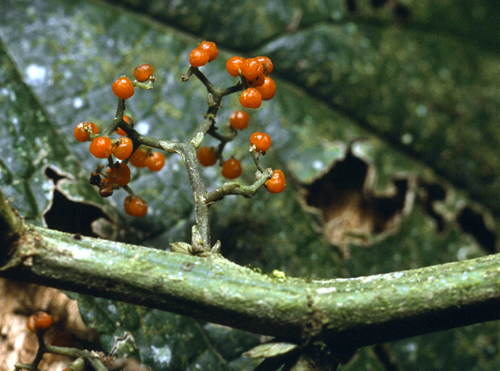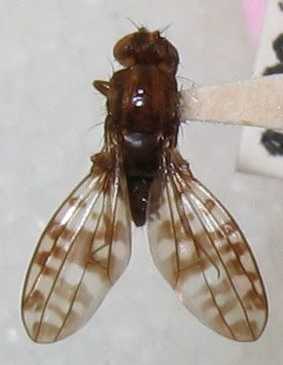|
Drosophila Aglaia
''Drosophila aglaia'' is an endangered species of fly from Hawaii. This species is a member of the ''aglaia'' subgroup of the picture-wing clade of Hawaiian Drosophilidae. It is only found on the island of Oahu, and has not been observed since 1997, when it was found in Palikea. Description ''Drosophila aglaia'' was described in 1965 by D. Elmo Hardy from specimens collected by O. H. Sweezey from Kilauae in 1917, and by G. B. Mainland from Kaala in 1946. This fly is described as predominantly yellow with brown eyes, three brown stripes on the top of the thorax, and characteristic brown markings on the wings. The abdomen is also brown with two yellow spots. '' Drosophila kikiko'' from the island of Kauai is described as nearly identical to ''D. aglaia''. While originally reported as breeding on the bark and stems of '' Urera glabra'', these records have since been attributed to the species '' Drosophila kinoole''. The actual host plant of ''D. aglaia'' is unknown. Conserva ... [...More Info...] [...Related Items...] OR: [Wikipedia] [Google] [Baidu] |
Endangered Species
An endangered species is a species that is very likely to become extinct in the near future, either worldwide or in a particular political jurisdiction. Endangered species may be at risk due to factors such as habitat loss, poaching and invasive species. The International Union for Conservation of Nature (IUCN) Red List lists the global conservation status of many species, and various other agencies assess the status of species within particular areas. Many nations have laws that protect conservation-reliant species which, for example, forbid hunting, restrict land development, or create protected areas. Some endangered species are the target of extensive conservation efforts such as captive breeding and habitat restoration. Human activity is a significant cause in causing some species to become endangered. Conservation status The conservation status of a species indicates the likelihood that it will become extinct. Multiple factors are considered when assessing the ... [...More Info...] [...Related Items...] OR: [Wikipedia] [Google] [Baidu] |
Hawaii
Hawaii ( ; haw, Hawaii or ) is a state in the Western United States, located in the Pacific Ocean about from the U.S. mainland. It is the only U.S. state outside North America, the only state that is an archipelago, and the only state geographically located within the tropics. Hawaii comprises nearly the entire Hawaiian archipelago, 137 volcanic islands spanning that are physiographically and ethnologically part of the Polynesian subregion of Oceania. The state's ocean coastline is consequently the fourth-longest in the U.S., at about . The eight main islands, from northwest to southeast, are Niihau, Kauai, Oahu, Molokai, Lānai, Kahoolawe, Maui, and Hawaii—the last of these, after which the state is named, is often called the "Big Island" or "Hawaii Island" to avoid confusion with the state or archipelago. The uninhabited Northwestern Hawaiian Islands make up most of the Papahānaumokuākea Marine National Monument, the United States' largest protected ... [...More Info...] [...Related Items...] OR: [Wikipedia] [Google] [Baidu] |
Hawaiian Drosophila
The Hawaiian Drosophilidae are a lineage of flies within the genus ''Drosophila.'' This monophyletic clade includes all of the endemic Hawaiian ''Drosophila'' and all members of the genus '' Scaptomyza'', which contains both Hawaiian and non-Hawaiian species. The Hawaiian Drosophilidae are descended from a common ancestor estimated to have lived 25 million years ago. Species of Hawaiian Drosophilidae flies have been studied as models of speciation and behavioral evolution. Along with other members of the native Hawaiian ecosystem, the conservations status of many species of Hawaiian Drosophilidae is threatened by habitat loss and introduced predators, among other factors. Diversity There are an estimated 1,000 species of Hawaiian Drosophilidae. 689 species have been described, including 273 species in the genus '' Scaptomyza'', of which 148 are endemic to the Hawaiian archipelago, and 416 Hawaiian endemic species in the genus ''Drosophila.'' Within the Hawaiian ''Drosophila'' ... [...More Info...] [...Related Items...] OR: [Wikipedia] [Google] [Baidu] |
Oahu
Oahu () (Hawaiian language, Hawaiian: ''Oʻahu'' ()), also known as "The Gathering place#Island of Oʻahu as The Gathering Place, Gathering Place", is the third-largest of the Hawaiian Islands. It is home to roughly one million people—over two-thirds of the population of the U.S. state of Hawaii. The island of O’ahu and the Northwestern Hawaiian Islands constitute the City and County of Honolulu, Hawaii, City and County of Honolulu. The state capital, Honolulu, is on Oʻahu's southeast coast. Oʻahu had a population of 1,016,508 according to the 2020 U.S. Census, up from 953,207 people in 2010 (approximately 70% of the total 1,455,271 population of the State of Hawaii, with approximately 81% of those living in or near the Honolulu urban area). Name The Island of O{{okinaahu in Hawaii is often nicknamed (or translated as) ''"The Gathering Place"''. It appears that O{{okinaahu grew into this nickname; it is currently the most populated Hawaiian islands, Hawaiian Island, how ... [...More Info...] [...Related Items...] OR: [Wikipedia] [Google] [Baidu] |
Otto Herman Swezey
Otto Herman Swezey (7 June 1869 – 3 November 1959) was an American entomologist who was an expert on the insects of Hawaii, especially the Lepidoptera. He described numerous species and many, like the psyllid genus '' Swezeyana'', have been named in his honour by other entomologists. Swezey was born in Rockford, Illinois to Adoniram Judson and Malinda Bruner. He studied at Guilford Centre School House and received a BA from Lake Forest College, Illinois in 1896. He obtained a MA from Northwestern University, Illinois. He studied entomology at the Ohio State University from 1902 to 1903 under Herbert Osborn. He worked in the Ohio State Department of Agriculture from 1903 to 1904. He investigated an outbreak of ''Perkinsiella saccharicida'' in Hawaii working with the Hawaiian sugar planters. After retirement in 1933 he worked at the Bernice P. Bishop Museum. Swezey received an honorary doctorate from the University of Hawaii in 1944. He served as the editor for the Proceedings of ... [...More Info...] [...Related Items...] OR: [Wikipedia] [Google] [Baidu] |
Kīlauea
Kīlauea ( , ) is an active shield volcano in the Hawaiian Islands. Located along the southeastern shore of the Big Island of Hawaii, the volcano is between 210,000 and 280,000 years old and emerged above sea level about 100,000 years ago. Historically, it is the most active of the five volcanoes that together form Hawaii island. Kīlauea is also one of the most active volcanoes on Earth, and the most recent and currently ongoing eruption began on September 29, 2021, when several vents began to erupt lava within Halemaʻumaʻu, a pit crater in the volcano's summit caldera. Kīlauea is the second-youngest product of the Hawaiian hotspot and the current eruptive center of the Hawaiian–Emperor seamount chain. Because it lacks topographic prominence and its activities historically coincided with those of Mauna Loa, Kīlauea was once thought to be a satellite of its much larger neighbor. Structurally, Kīlauea has a large, fairly recently formed caldera at its summit and two ac ... [...More Info...] [...Related Items...] OR: [Wikipedia] [Google] [Baidu] |
Drosophila Kikiko
''Drosophila'' () is a genus of flies, belonging to the family Drosophilidae, whose members are often called "small fruit flies" or (less frequently) pomace flies, vinegar flies, or wine flies, a reference to the characteristic of many species to linger around overripe or rotting fruit. They should not be confused with the Tephritidae, a related family, which are also called fruit flies (sometimes referred to as "true fruit flies"); tephritids feed primarily on unripe or ripe fruit, with many species being regarded as destructive agricultural pests, especially the Mediterranean fruit fly. One species of ''Drosophila'' in particular, '' D. melanogaster'', has been heavily used in research in genetics and is a common model organism in developmental biology. The terms "fruit fly" and "''Drosophila''" are often used synonymously with ''D. melanogaster'' in modern biological literature. The entire genus, however, contains more than 1,500 species and is very diverse in appea ... [...More Info...] [...Related Items...] OR: [Wikipedia] [Google] [Baidu] |
Kauai
Kauai, () anglicized as Kauai ( ), is geologically the second-oldest of the main Hawaiian Islands (after Niʻihau). With an area of 562.3 square miles (1,456.4 km2), it is the fourth-largest of these islands and the 21st largest island in the United States. Nicknamed the Garden Isle, Kauai lies 73 miles (117 km) across the Kauai Channel, northwest of Oahu. This island is the site of Waimea Canyon State Park and the Na Pali Coast State Park. The United States Census Bureau defines Kauai as census tracts 401 through 409 of Kauai County, Hawaii, which comprises all of the county except the islands of Kaʻula, Lehua and Niihau. The 2020 United States census population of the island was 73,298. The most populous town is Kapaa. Etymology and language Hawaiian narrative locates the name's origin in the legend of Hawaiiloa, the Polynesian navigator credited with discovery of the Hawaiian Islands. The story relates how he named the island of Kauai after a favorite son; ... [...More Info...] [...Related Items...] OR: [Wikipedia] [Google] [Baidu] |
Urera Glabra
''Urera'' is a genus of flowering plants in the nettle family, Urticaceae. It has a pantropical distribution.Steinmann, V. W. (2005)Four new neotropical species and a new combination of ''Urera'' (Urticaceae).''Acta Botánica Mexicana'' (71), 19-43. Description ''Urera'' are lianas,''Urera''. Flora Zambesiaca. s, and small trees. Climbing species root along the stems and can reach the crowns of the trees they use for support. Some are spiny. They almost always have [...More Info...] [...Related Items...] OR: [Wikipedia] [Google] [Baidu] |
Drosophila Kinoole
''Drosophila'' () is a genus of flies, belonging to the family Drosophilidae, whose members are often called "small fruit flies" or (less frequently) pomace flies, vinegar flies, or wine flies, a reference to the characteristic of many species to linger around overripe or rotting fruit. They should not be confused with the Tephritidae, a related family, which are also called fruit flies (sometimes referred to as "true fruit flies"); tephritids feed primarily on unripe or ripe fruit, with many species being regarded as destructive agricultural pests, especially the Mediterranean fruit fly. One species of ''Drosophila'' in particular, ''D. melanogaster'', has been heavily used in research in genetics and is a common model organism in developmental biology. The terms "fruit fly" and "''Drosophila''" are often used synonymously with ''D. melanogaster'' in modern biological literature. The entire genus, however, contains more than 1,500 species and is very diverse in appearance, be ... [...More Info...] [...Related Items...] OR: [Wikipedia] [Google] [Baidu] |
Pheidole Megacephala
''Pheidole megacephala'' is a species of ant in the family Formicidae. It is commonly known as the big-headed ant in the USA and the coastal brown ant in Australia. It is a very successful invasive species and is considered a danger to native ants in Australia and other places. It is regarded as one of the world's worst invasive ant species.''Pheidole megacephala'' Global Invasive Species Database, 3 Aug 2011 (archived) Distribution ''Pheidole megacephala'' was described from a specimen from the island of Mauritius by the Entomology, entomologist Johan Christian Fabricius in 1793, although a 1775 record exists for Egypt, under the name ''Formica edax''. Regardless of its origin, big-headed ants have since spread to many tropical and subtropical par ...[...More Info...] [...Related Items...] OR: [Wikipedia] [Google] [Baidu] |
Anoplolepis Longipes
The yellow crazy ant (''Anoplolepis gracilipes''), also known as the long-legged ant or Maldive ant, is a species of ant, thought to be native to West Africa or Asia. They have been accidentally introduced to numerous places in the world's tropics. The yellow crazy ant has colloquially been given the modifier "crazy" on account of the ant's erratic movements when disturbed. Its long legs and antennae make it one of the largest invasive ant species in the world.''Anoplolepis gracilipes''. Global Invasive Species Database. ISSG. Like several other invasive ants, such as the red imported fire ant (''''), the big-headed ant ('' |







